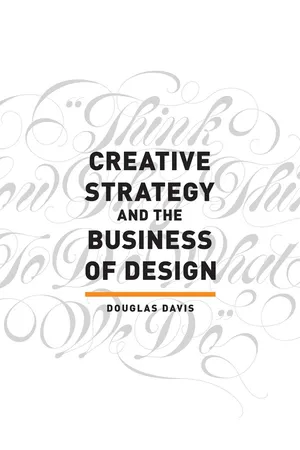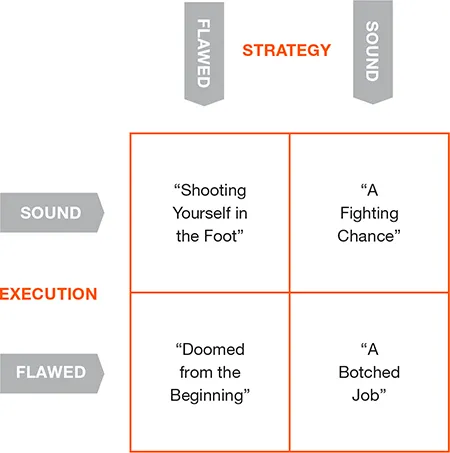![]()
PART I
A Designer Caught in the Headlights: Creative Business Solutions
![]()
1 Welcome to the Other Side of the Brain
Business Concepts Creatives Should Understand
It was only sixty minutes into my first statistics class—in the first week of my first semester at New York University—but I was already exceeding my median threshold for pain. Why was this a good idea again? I already had a Master’s degree from Pratt Institute and a thriving career as a freelance art director who even taught an undergraduate class or two on the side. Nothing from the last hour was in any way familiar. What the hell did I just do? Each class I would fall further and further behind on the calculating and formulas and steps. Everything in me screamed This is the wrong side of the brain! I felt like Charlie Brown—everything I heard sounded like “wah-wah, wah-wah-wah-wah.” I asked the professor for help. I asked my classmates for help. I failed the midterm. I paid a tutor for lessons twice a week and I wanted to quit before it all had really even begun. Though everyone else was competing for the highest score, I was only determined to make sure this class didn’t defeat the whole purpose. On the final day, I slowly flipped my exam over and opened my eyes to see what I scored, and lo and behold, I was overjoyed to see that after my absolute best effort, I passed with a C. Academic probation never felt so good.
In a nutshell, I can say to you: the material in this book will sometimes make you feel like a creative person in a math class—it’ll take some time and effort to grasp. Then, even after you want to grasp it, it takes some more time until it becomes second nature, so be patient with yourself. Trust me—it’s worth it. Submerging myself into the world of “how they think” (a.k.a. the business world) slowly taught me why I lost the battles I did. The more integrated marketing classes I digested, the more I understood that an argument based on pure aesthetics was doomed unless it could be tied to accomplishing a business objective. This expedition to the other side of the brain helped me understand in detail what the difference is between art—a personal expression—and design/advertising—art with a commercial purpose.
STRATEGY VERSUS EXECUTION
Confused about what’s strategy and what’s execution? Think of it this way: When sitting down to play chess, your goal is to win by capturing the king. Thinking through the plan that details the pieces and process you’ll use to do it is creating your strategy. The way you carry out that strategy, the actual moves themselves, or the tactics, are the execution. You’ll hear people on the business or marketing side of things critique our ideas as “tactical” or “strategic” based on what’s needed.
D-School Crashes B-School
After a year of kicking and screaming, I started to see the benefit of the way they think. Surprisingly, it increased the relevance/effectiveness of my creative work. In the Fred Nickols paper “Strategy IS Execution: What You Do Is What You Get,” he states that “strategy as contemplated and strategy as realized are often two very different matters. Strategy as realized is the outcome of efforts to execute strategy as contemplated.” It makes sense that if creative people are included at the table contemplating strategy from the outset, the more likely that strategy is to be realized when they execute. When I apply this thinking to our creative profession, it underscores my belief that injecting creativity into the beginning of a business discussion is the way to boost the success of the outcome. More importantly for the long term, it is the way to make the value of your relationship with the client invaluable. Relegating creativity to the execution or the end of solving a problem is an unfortunate misstep in a world of increased emphasis on aesthetics and design process. Our creative jobs are even more essential to business than in the past because of the way business is annexing design, as it previously integrated marketing. This concept isn’t new: Thomas Watson Jr.’s comment in 1973 states that “good design is good business.” However, the power and impact that design has had on business (as evidenced by visionaries like Steve Jobs) is reflected in the top business consulting firms like McKinsey&Compamy, advising in their article “Building a design-driven culture,” that “[i]t’s not enough to just sell a product or service—companies must truly engage with their customers.” To bottom-line it, right-brained creativity is the spoonful of sugar that makes the business or marketing objectives (the left-brained component) palatable to the public.
I’ve watched clients’ expectations evolve to the point that they now expect each person involved with their brand to be strategic. This includes the people tasked with building the customer-facing aspects of their communications—i.e., creative people, us. It doesn’t matter that D-school doesn’t focus heavily (if at all) on strategy or that B-school doesn’t teach how to inspire creative people. Creative business solutions that have both rational and creative parts at their core are essential to differentiating you and your work from the pack.
Nickols’ Strategy-Execution Matrix underscores the necessity of both parts of the brain working in harmony to even have a chance at creating something great. As our world becomes increasingly integrated, I’d argue that any approach that doesn’t have equal parts right-brained creative problem-solving and left-brained strategic thinking will have a struggle making it through the internal process, much less making it to market.
Chart courtesy of Fred Nickols.
Sound Execution + Flawed Strategy = Shooting Yourself in the Foot.
Sound Execution + Sound Strategy = A Fighting Chance.
Flawed Execution + Flawed Strategy = Doomed from the Beginning.
Flawed Execution + Sound Strategy = A Botched Job.
YOU DON’T HAVE TO MEMORIZE THESE
Feel free to refer back to this section whenever necessary. It’s not written in disappearing ink. Some of these terms are difficult to digest, so don’t feel like you need to master them all in one try.
The Language of Business
If you’ve ever been in a meeting and everything that the client, account manager, or strategic planner said sounded like a foreign language, I understand. Business is spoken with the other side of the brain. Think of it as something like learning to draw with your nondominant hand—it will take a bit of getting used to.
Learning to speak the language is just the first part. In order to do what we’re here to do, we’ve got to speak and understand the words being spoken around us. But, as you know, things get lost in translation. In this chapter, we’ll start with the exposure to and translation of several key concepts. I’d like to help you connect with your clients and add value to your relationships by explaining how you can interpret the rational language of business while translating it into the emotional language of design.
If I had to cherry-pick the concepts most relevant to designers, writers, and art directors, it would be these. I’ll give the gist of the concept first and then give scenarios that could help you incorporate these concepts into your approach to problem-solving.
Key Terms You Need to Know
The terms in this next section are not exhaustive, but are some of the usual suspects. If you want to impress a dinner date, this is what you’ve been doing at work all these years. I’ve organized this section in order from what you may encounter the most in your everyday job to the higher-level concepts you may face as you become more seasoned. The list ends with a framework to organize all this in a way that will help you create from it.
A key point: these terms are always relative. Meaning, the term used might vary from company to company or situation to situation—it depends on the person using it, the culture of the agency, and so on. Use the context you see the term in to help guide you toward what’s being referenced. If necessary, ask for clarification!
Understanding these key business concepts will allow you to:
- Build your creative concepts on a solid strategic understanding.
- Ask relevant questions that help fill in the blanks when information is vague or incomplete.
- Win new and grow existing business relationships.
When you’re really able to use these terms correctly, eyebrows will raise.
[ INSIGHT ]
WHAT IS IT?
In this context, an insight is the gold that we mine from company data, target-market research, or brand history to inspire our creative concepts. Insights are a set of conclusions rooted in truth that you can think of as distilled inspiration. When looking at data on sales or behaviors, questions like these can lead to insights:
- What is it telling us about the people we are observing and the...

